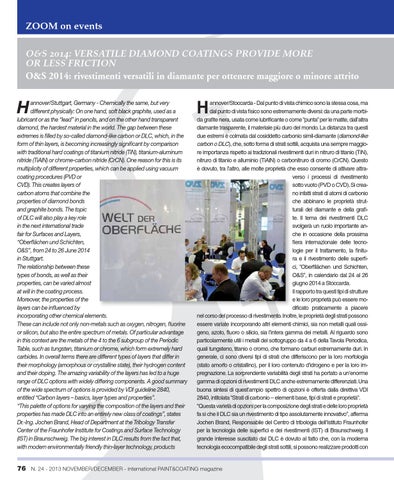ZOOM on events O&S 2014: VERSATILE DIAMOND COATINGS PROVIDE MORE OR LESS FRICTION O&S 2014: rivestimenti versatili in diamante per ottenere maggiore o minore attrito
H
annover/Stuttgart, Germany - Chemically the same, but very different physically: On one hand, soft black graphite, used as a lubricant or as the “lead” in pencils, and on the other hand transparent diamond, the hardest material in the world. The gap between these extremes is filled by so-called diamond-like carbon or DLC, which, in the form of thin layers, is becoming increasingly significant by comparison with traditional hard coatings of titanium nitride (TiN), titanium-aluminum nitride (TiAlN) or chrome-carbon nitride (CrCN). One reason for this is its multiplicity of different properties, which can be applied using vacuum coating procedures (PVD or CVD). This creates layers of carbon atoms that combine the properties of diamond bonds and graphite bonds. The topic of DLC will also play a key role in the next international trade fair for Surfaces and Layers, “Oberflächen und Schichten, O&S”, from 24 to 26 June 2014 in Stuttgart. The relationship between these types of bonds, as well as their properties, can be varied almost at will in the coating process. Moreover, the properties of the layers can be influenced by incorporating other chemical elements. These can include not only non-metals such as oxygen, nitrogen, fluorine or silicon, but also the entire spectrum of metals. Of particular advantage in this context are the metals of the 4 to the 6 subgroup of the Periodic Table, such as tungsten, titanium or chrome, which form extremely hard carbides. In overall terms there are different types of layers that differ in their morphology (amorphous or crystalline state), their hydrogen content and their doping. The amazing variability of the layers has led to a huge range of DLC options with widely differing components. A good summary of the wide spectrum of options is provided by VDI guideline 2840, entitled “Carbon layers – basics, layer types and properties”. “This palette of options for varying the composition of the layers and their properties has made DLC into an entirely new class of coatings”, states Dr.-Ing. Jochen Brand, Head of Department at the Tribology Transfer Center of the Fraunhofer Institute for Coatings and Surface Technology (IST) in Braunschweig. The big interest in DLC results from the fact that, with modern environmentally friendly thin-layer technology, products
annover/Stoccarda - Dal punto di vista chimico sono la stessa cosa, ma dal punto di vista fisico sono estremamente diversi: da una parte morbida grafite nera, usata come lubrificante o come “punta” per le matite, dall’altra diamante trasparente, il materiale più duro del mondo. La distanza tra questi due estremi è colmata dal cosiddetto carbonio simil-diamante (diamond-like carbon o DLC), che, sotto forma di strati sottili, acquista una sempre maggiore importanza rispetto ai tradizionali rivestimenti duri in nitruro di titanio (TiN), nitruro di titanio e alluminio (TiAlN) o carbonitruro di cromo (CrCN). Questo è dovuto, tra l’altro, alle molte proprietà che esso consente di attivare attraverso i processi di rivestimento sotto vuoto (PVD o CVD). Si creano infatti strati di atomi di carbonio che abbinano le proprietà strutturali del diamante e della grafite. Il tema dei rivestimenti DLC svolgerà un ruolo importante anche in occasione della prossima fiera internazionale delle tecnologie per il trattamento, la finitura e il rivestimento delle superfici, “Oberfllächen und Schichten, O&S”, in calendario dal 24 al 26 giugno 2014 a Stoccarda. Il rapporto tra questi tipi di strutture e le loro proprietà può essere modificato praticamente a piacere nel corso del processo di rivestimento. Inoltre, le proprietà degli strati possono essere variate incorporando altri elementi chimici, sia non metalli quali ossigeno, azoto, fluoro o silicio, sia l’intera gamma dei metalli. Al riguardo sono particolarmente utili i metalli del sottogruppo da 4 a 6 della Tavola Periodica, quali tungsteno, titanio o cromo, che formano carburi estremamente duri. In generale, ci sono diversi tipi di strati che differiscono per la loro morfologia (stato amorfo o cristallino), per il loro contenuto d’idrogeno e per la loro impregnazione. La sorprendente variabilità degli strati ha portato a un’enorme gamma di opzioni di rivestimenti DLC anche estremamente differenziati. Una buona sintesi di quest’ampio spettro di opzioni è offerta dalla direttiva VDI 2840, intitolata “Strati di carbonio – elementi base, tipi di strati e proprietà”. “Questa varietà di opzioni per la composizione degli strati e delle loro proprietà fa sì che il DLC sia un rivestimento di tipo assolutamente innovativo”, afferma Jochen Brand, Responsabile del Centro di tribologia dell’Istituto Fraunhofer per la tecnologia delle superfici e dei rivestimenti (IST) di Braunschweig. Il grande interesse suscitato dal DLC è dovuto al fatto che, con la moderna tecnologia ecocompatibile degli strati sottili, si possono realizzare prodotti con
H
76 N. 24 - 2013 NOVEMBER/DECEMBER - international PAINT&COATING magazine
